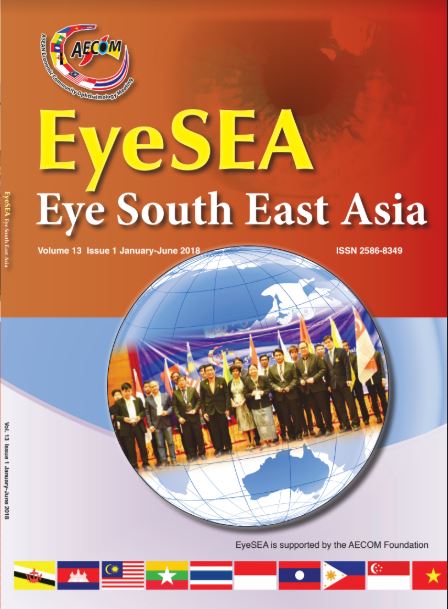A comparative study of ocular aberrations: before and after pterygium surgery.
Main Article Content
Abstract
Background: Pterygium can distort the corneal surface of the eye, causing astigmatism and higher-order aberrations that affect vision. Pterygium surgery may reduce ocular aberrations.
Purpose: To evaluate the effect of pterygium excision on ocular aberrations.
Methods: Thirty-two patients with primary pterygium were enrolled. Values of ocular aberration consisting of defocus, astigmatism, secondary astigmatism, coma, secondary coma, trefoil, spherical aberration, quadrafoil and pentafoil were measured with wavefront analysis technique. These parameters were recorded before and one-month after the pterygium excision. Results were analyzed by paired t-test.
Results: Of the 32 patients, there were 9 males (28%) and 23 females (72%), mean age was 58.4+/-10.6 years. Mean ratio of pterygium size to a corneal diameter was 0.31+/-0.02. Fourteen patients (44%) had uncorrected visual acuity greater than 20/40 in the affected eyes, and 21 patients (66%) had visual acuity greater than 20/40 after pterygium excision. Mean values of ocular aberrations in micrometers (before and after surgery) were 0.91±0.88, 0.45±0.75 for defocus, 0.22±0.52, 0.32±0.19 for astigmatism, 0.09±0.81, -0.01±0.07 for secondary astigmatism, -0.03±0.20, -0.07±0.12 for coma, -0.05±0.10, 0.02+/-0.03 for secondary coma, 0.70±0.45, 0.09±0.15 for trefoil, -0.01±0.07, 0.01±0.03 for secondary trefoil, 0.29±0.08, 0.05±0.05 for spherical aberration, -0.10±0.13, 0.14±0.09 for quadrafoil and -0.02±0.09, 0.02+/-0.04 for pentafoil. All parameters showed no statistical difference pre-surgery and one-month post-surgery (p>0.05) except for spherical aberration (p=0.012).
Conclusion: Excision of pterygium can reduce spherical aberration.
Conflict of interest: none.
Article Details
References
2. Kampitak K, Leelawongtawun W, Leeamornsiri S, Suphachearaphan W, Thitiwichienlert S. A Comparative Study of Higher order Aberrations between Pterygium and Non-Pterygium Eyes. J Med Assoc Thai 2016; 99(Suppl. 4): S178-81.
3. Lin A, Stern G. Correlation between pterygium size and induced corneal astigmatism. Cornea. 1998; 17(1): 28-30.
4. Hansen A, Norn M. Astigmatism and surface phenomena in pterygium. Acta Ophthalmol. 1980; 58(2):174-81.
5. Khan FA, Khan Niazi S, Khan DA. The impact of pterygium excision on corneal astigmatism. J Coll Physicians Surg Pak. 2014;24(6):404-7.
6. Bedrossian, R.H. The effects of pterygium surgery on refraction and corneal curvature. Arch Ophthalmol. 1960; 64: 553–7.
7. Yagmar M, Altan A, Ozcan MD, Sari S, Ersoz RT. Visual acuity and corneal topographic changes related with pterygium surgery. J Refract Surg. 2005; 21: 166–70.
8. Pesudovs K, Figueiredo FC. Corneal first surface wavefront aberrations before and after pterygium surgery. J Refract Surg. 2006; 22(9): 921-5.
9. Razmjoo H, Vaezi MH, Peyman A, Koosha N, Mohammadi Z, Alavirad M. The effect of pterygium surgery on wavefront analysis. Adv Biomed Res. 2014; 3:196.
10. Ozgurhan EB, Kara N, Cankaya KI, et al. Corneal wavefront aberrations after primary and recurrent pterygium surgery. Eye Contact Lens 2015; 41:378–81.
11. Stern GA, Lin A. Effect of Pterygium Excision on Induced Corneal Topographic Abnormalities. Cornea. 1998;17(1):23-7.
12. Gumus K, Erkilic K, Topaktas D, Colin J. Effect of pterygia on refractive indices, corneal topography, and ocular aberrations. Cornea. 2011; 30(1):24-9.
13. Gumus K, Topaktas D, Göktas A, Karakucuk S, Oner A, Mirza GE. The Change in Ocular Higher-Order Aberrations AfterPterygium Excision With ConjunctivalAutograft: A 1-Year Prospective Clinical Trial. Cornea. 2012; 31(12):1428-31.


